
When it comes time to assess your marketing efforts, it's not uncommon for you to run into a ton of questions.
How are your contacts trending month over month? Was the time you spent creating social media graphics for that campaign worth it? And what about your email marketing efforts? How are those stacking up against your paid initiatives?
So many questions, so little time ...
And while it's easy to get lost in a mess of reports and numbers when you go looking for answers, it doesn't have to be that way. To save you some time, we've put together a list of common marketing questions that you can answer with your analytics alongside tips on how to arrive at the answers you've been searching for.
We're going to walk through how to uncover this information using the HubSpot software, but if you have another marketing or analytics software, you should be able to take a similar approach.
How to Get the Answers to These 11 Common Marketing Questions Using Analytics
1) How many contacts were created from a specific campaign?
In order to successfully track the effectiveness of your marketing campaign, you'll need to start by setting goals for how many visits, contacts, and customers you want to generate. You can even get more specific and set goals for how many visits, contacts, and customers you want generated from different aspects of the campaign such as social media, email marketing, or your blog. For tips on how to set marketing goals for your campaign, check out our free smart goals template.
When the campaign has completed, compare your goals against your results. This will help you figure out what you should expect from future campaigns and assess whether or not you ran a successful campaign.
If you use HubSpot's Campaigns App, you will be able to see this information at the top of your campaign dashboard. From here, you can dig into the metrics of specific assets within the campaign to figure out what worked for your company and what you need to improve on for the future.

2) How many contacts is my blog generating?
After you produce content for your blog, it is important to figure out if you are actually generating contacts as a result. You'll also want to determine what types of content are working well in terms of topics, blog titles, formatting, and promotion.
To do this in HubSpot, you need to run an Attribution Report broken down by Referrer and Last Interaction. This report will show you the content that your contacts viewed before going to a landing page and converting. To begin your analysis, simply filter the report to just focus on blog posts. As mentioned before, you can do similar analyses in other analytics tools such as Google Analytics.
For additional tips on how to measure your blog's performance, we put together a blog post that goes through how to run a blog lead generation analysis.

3) What actions did specific contacts take on my site before becoming a customer?
As marketers, part of our job is to figure out the path that our contacts take on their journey to becoming a customer. We want to find trends or patterns in this path in and effort to decrease the time it takes for someone to go from being a contact to a customer. We also want to figure out the key pieces of content that someone needs to hit on our site before converting. By uncovering this type of specific information, we can then find creative ways to present that content earlier on in the contact to customer journey.
In order to do this, you need a way to see this journey and understand everything that someone is interacting with from the moment they come to your site until they become a customer. You need to understand what emails they opened and clicked, what blog posts they read, and what pages they interacted with on your website.
In HubSpot you can do all of this through the contact timeline. This display allows you to dive into each individual contact separately to generate a better understanding of the steps they've taken towards becoming a customer so that you can make more informed decisions when creating and distributing content.

4) What are my most popular blog posts?
In order to determine you most popular posts, you'll need to figure out which ones are driving the most traffic. This is an important metric to understand because not every blog visitor is going to convert after reading one post. In fact, most businesses find that they need to generate a ton of initial traffic to their blog posts before they can begin to generate and measure conversions.
In HubSpot you can see this information on the Blog Dashboard. This will give you an overview of how may visits your blog has generated in the current month, as well as the total views your most recent blog articles have generated. If you want to see more of your blog posts -- and how much traffic they generated -- you can go into the published tab to view the total number of visits from each blog post.
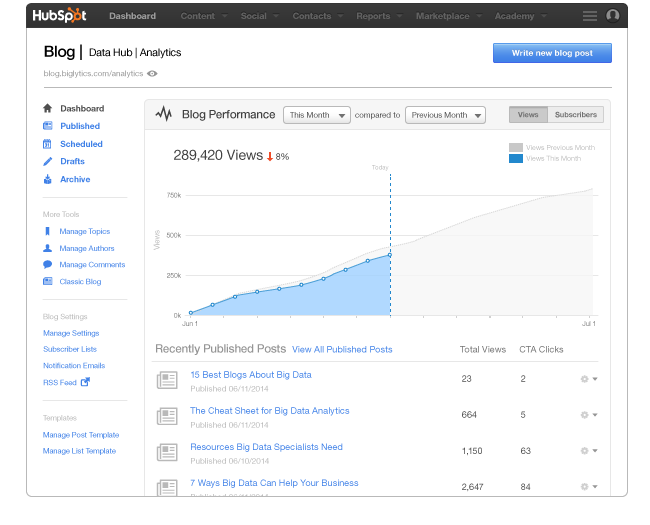
5) What website content is converting the most leads?
Blog posts aren't the only pieces of content that get people to convert on your website. In fact, your home page, about us page, product pages, and landing pages also play a huge role in driving conversions throughout your website.
Identifying these key pages serves as an important step in figuring out what pages you should use to nurture your contacts. For example, if you know that before someone becomes a customer, they always look at your product page, you should make sure they see that page as early as possible in their customer journey.
You can uncover this data in HubSpot by running an Attribution Report. Simply create a report based on the URL and All interactions to see the most valuable pages that people are interacting with on your website. Once you've identified these pages, you can then make sure that they are being seen early and often by your website visitors by adjusting their placement.

6) What marketing channels are generating the most contacts?
Whenever you run a campaign, it's important to make note of how many contacts each specific element -- email, social, paid, organic search, direct traffic -- generated.
This information is key in figuring out where you should focus your team's efforts. If you see that you are putting a lot of time and effort into your email marketing, but it isn't generating many contacts, you may need to rethink your email strategy or focus on another channel that is turning up more contacts.
If you do not have HubSpot, you can use tracking URLs to keep track of where your contacts are coming from. However, if you do use HubSpot, there's a handy Sources Report that will show you which marketing channels are producing the most contacts. This serves as a quick and easy way to analyze the performance of your channels.
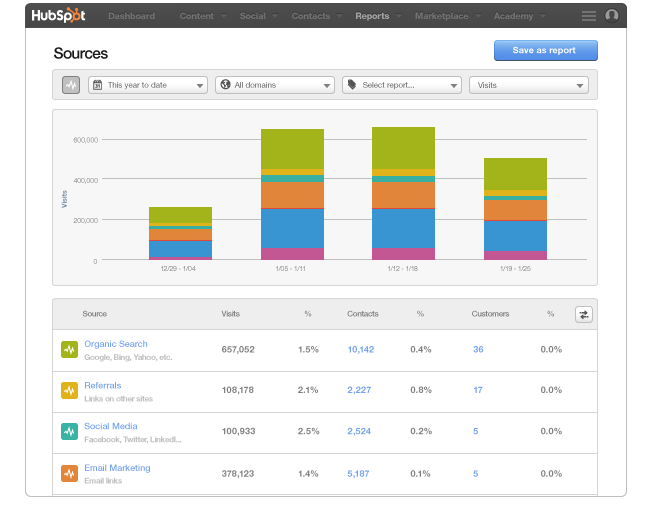
7) What marketing channels have the highest contact to customer conversion rate?
Generating contacts from your campaigns is important, but ensuring that those contacts are high quality is even more important. That's where the contact-to-customer conversion rate comes in. This number will show the percent of contacts that are converting into paying customers. And while lead generation is important, if they are not turning into customers, your efforts may be better used elsewhere.
Let's say you've found that email marketing has generated 5,187 contacts, and referrals have generated 2,227 contacts. However, the contact-to-customer conversion rate for email marketing is .1% while it is .8% for referrals. Even though you are generating more contacts with your email marketing efforts, you are generating a higher conversion rate from referrals. And that's what matters.
If you are a HubSpot customer, you can easily find this information in your Sources Report.

8) How many contacts do I have in each persona?
One of the most important steps you need to take is figuring out your buyer personas. By doing this you will be able to determine what type of marketing works best for different segments of your database so that you can target your audience with messages that are more relevant to their interests and needs.
After you figure out who your personas are (and segment your database with this information), you can then begin to adapt your marketing. This will require you to not only send different emails to different personas, but also employ more specific lead nurturing resources based on what you know about each segment.
No matter what marketing software you use, it is important to make sure each contact in your database has a property associated with them that indicates what persona they belong to. This will make it easier for you to segment by this information in the future.
If you are using HubSpot you can do this right from the Personas App in the Dashboard. Not only will this app will help you figure out who belongs to what persona, but it will also make sure that whenever someone new comes to your website and converts into a contact, they are tagged with a specific persona.
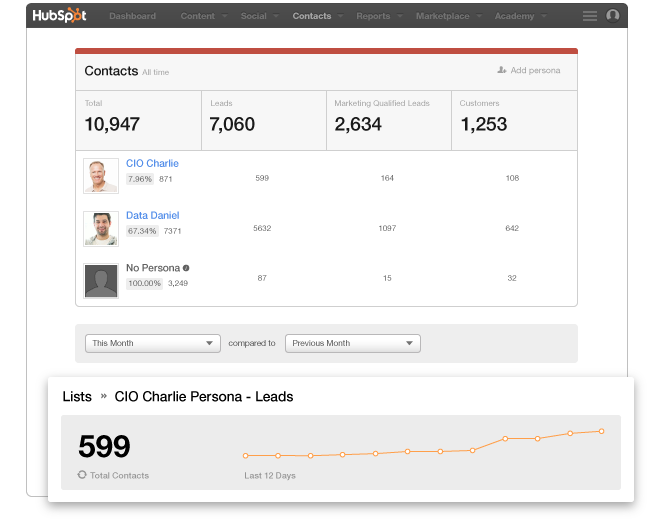
9) How much revenue did my company generate this month?
Throughout the month it is important to track how much revenue your company is generating to see if you are ahead of goal, behind, or on track. Typically this is done in your CRM, but you may also be able to do it in your marketing software.
Keeping tabs on this information will help you understand how your marketing efforts are translating into actual revenue generated for the company. Once you uncover this information, you can then use it to determine where you should focus your marketing efforts for the next month.
If you are a HubSpot customer, you can do this in either a Contacts or a Companies Report. If you are a B2C company, use the Contacts Report. If you are a B2B company, use the Companies Report. Once you pull up the appropriate report, you can then easily visualize how you are trending toward your monthly revenue goals using the graph.
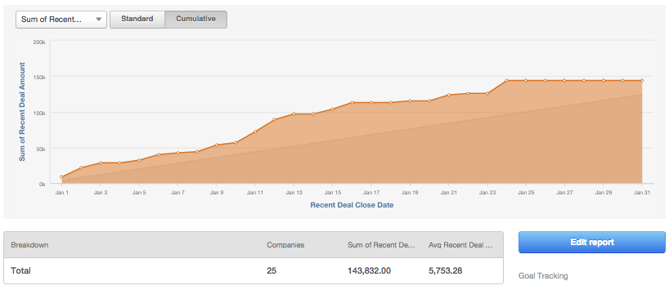
10) How do I see my blog subscriber growth over time?
An important element of growing your blog is increasing the number of subscribers. This is because more subscribers often translate to a more consistent source of traffic to your blog. Not to mention, these subscribers may even begin to refer additional traffic to your blog over time.
To keep track of subscriber growth, you'll want to monitor the number of new subscribers in a given time period based on the subscriber form you have on your blog or website. If you are a HubSpot customer you can do this right in the Blog Dashboard. Simply mouse over to the Subscribers tab, and you will see how your subscribers are trending from one month to another.
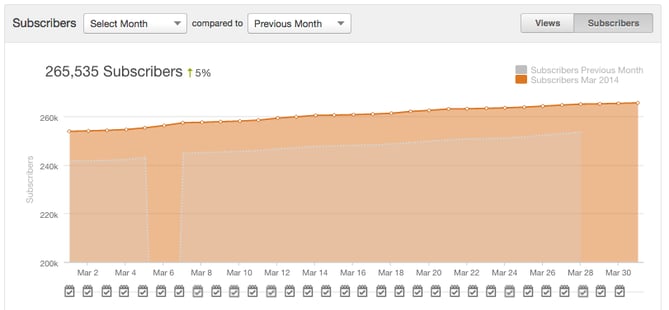
11) How are we tracking toward our monthly contacts goal?
Most marketers have a monthly contact number that they are measured on, and how you are trending toward that goal can determine how many campaigns you may need to run in a given month. If you find that you're way below the goal and in danger of not hitting it, you may need to add in a few extra campaigns or additional blog posts to help you get your numbers up.
If you are a HubSpot customer, you can insert goal tracking into your Contacts Report graph to monitor if you are ahead, on track, or behind your goal.

What other marketing questions do you have? Let us know in the comments section below.
To view the original article Click Here

No comments:
Post a Comment